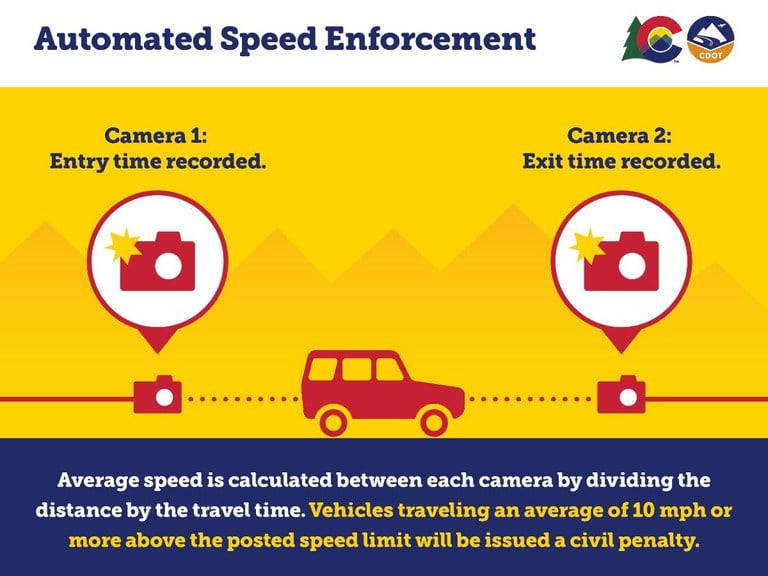CDOT announces start of Colorado Speed Enforcement Program on CO 119
News Release
Statewide — Following a record-breaking year for work zone fatalities, the Colorado Department of Transportation is launching the Colorado Speed Enforcement Program. The new program deploys camera technology along CDOT-owned corridors with active construction work zones aiming to reduce speed-related crashes and fatalities on Colorado roads and improve safety for all motorists, including drivers, road workers, vulnerable road users and law enforcement.
In 2024, work zone crashes in Colorado resulted in 567 injuries and 31 fatalities — nearly double the number of deaths from the previous year. To address this alarming trend, CDOT’s Colorado Speed Enforcement Program will implement Automated Vehicle Identification Systems (AVIS) in high-risk corridors to identify vehicles traveling an average of 10 mph or more over the posted speed limit.
“Work zones are high-risk areas with narrow and shifting lanes, closures and sudden stops, making speeding especially dangerous,” said CDOT Chief Engineer Keith Stefanik. “This program is about protecting lives, not punishing drivers. Enforcing compliance with posted speed limits means safer roads statewide for all.”
In active enforcement zones, vehicles will be photographed and timestamped at two points. The system then calculates the average speed between each camera by dividing the distance by the travel time. Vehicles traveling an average of 10 mph or more over the posted speed limit will be issued a $75 civil penalty.
To give motorists time to adjust, the program will include a warning period before civil penalties are enforced this fall. When the warning period begins, violators will receive only one warning, regardless of the number of times they violate the program. Warnings and notices will be mailed to the vehicle’s registered owner within 30 days of the violation.

Starting July 21, the program will issue warnings along the active work zone on Colorado Highway 119, also known as the “Diagonal Highway,” between Longmont and Boulder. Civil penalties will be issued later this year. In 2025, CDOT’s focus will remain on construction work zones, but the program is expected to expand into school zones and other high-risk corridors in the future.
“The rising number of work zone fatalities is unacceptable. Automated speed cameras take enforcement to the next level and can help prevent needless deaths with or without law enforcement presence,” said Col. Matthew C. Packard, chief of the Colorado State Patrol. “Speeding remains a leading cause of crashes. Motorists must be reminded that slow is safe.”
CDOT emphasizes transparency in this initiative. All active enforcement zones will be published on codot.gov, and each location will include a warning period of at least 30 days. “Camera speed enforcement ahead” signs will also be posted at the entrance to every active work zone.
In 2023, the Colorado General Assembly passed Revised Statute 42-4-110.5, expanding the use of AVIS to enforce speed compliance. Many local government agencies have already implemented cameras and sensors along high-risk driving corridors in efforts to make their communities safer for pedestrians and motorists.
For more information about the Colorado Speed Enforcement Program, visit codot.gov/programs/speedenforcement.
About the Colorado Speed Enforcement Program
In 2024, speeding was the most common cause of fatal crashes in Colorado. The dangers of speeding are especially high in work zones, where challenging conditions and vulnerable roadside workers create hazardous circumstances. The Colorado Department of Transportation’s Colorado Speed Enforcement Program aims to reduce speed-related crashes and fatalities on Colorado roads and improve safety for drivers, road workers, vulnerable road users and law enforcement. Using Automated Vehicle Identification Systems (AVIS) in high-risk, CDOT-owned corridors, cameras identify vehicles traveling an average of 10 mph or more over the posted speed limit and automatically issue $75 civil penalties to the registered owner of the vehicle. The program will start first on Colorado Highway 119 and is expected to expand into school zones and other high-risk corridors in the future. More information about the Colorado Speed Enforcement Program can be found at codot.gov/programs/speedenforcement.
Remember: Slow For The Cone Zone
The following tips are to help you stay safe while traveling through maintenance and construction work zones.
- Do not speed in work zones. Obey the posted speed limits.
- Stay Alert! Expect the unexpected.
- Watch for workers. Drive with caution.
- Don't change lanes unnecessarily.
- Avoid using mobile devices such as phones while driving in work zones.
- Turn on headlights so that workers and other drivers can see you.
- Be especially alert at night while driving in work zones.
- Expect delays, especially during peak travel times.
- Allow ample space between you and the car in front of you.
- Anticipate lane shifts and merge when directed to do so.
- Be patient!
Download the COtrip App!
The new free COtrip Planner mobile app was designed to meet the growing trend of information on mobile and tablet devices for the traveling public. The COtrip Planner app provides statewide, real-time traffic information, and works on mobile devices that operate on the iOS and Android platforms. Visit the Google Play Store (Android devices) or the Apple Store (iOS devices) to download!
